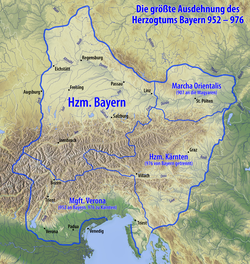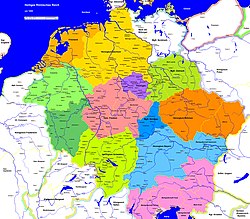Historical context
After the last Agilolfing duke of Bavaria, Tassilo III, was deposed in 788, Charlemagne and his successors placed Bavaria under the rule of non-hereditary governors and civil servants. By the late 9th century however, Frankish direct power had waned in the region. The conquests of the Hungarians and their recurring invasions had allowed Bavaria's local rulers to grab greater independence.
Margrave Luitpold, the progenitor of the Luitpoldings, set himself up as the most prominent of Bavaria's aristocracy and thereby laid the foundations of the renewed stem duchy.
Origins
Ernstides and Huosi
Luitpold's descent has not been conclusively established. Luitpold and his ancestors are said to have been an offshoot of the early medieval Bavarian Huosi, one of the five leading Bavarian dynasties during the time of the formation of the Bavarian tribes, who flourished in the 8th and 9th century. [1]
His father may have been Ernst II, of the Ernstides dynasty [ de]. In this case, his aunt would have been married to Gebhard of the Lahngau, the progenitor of the Conradines. A namesake, Luitpold, who died in 846, could have been a relative.
Emperor Arnulf of Carinthia calls him a blood relative and a cousin. This relation may have gone through Luitpold's father Ernst II, whose possible sister Liutswind was married to the Carolingian King Carloman of Bavaria, and were the parents of Arnulf. If correct, this would explain the transmission of the dukedom of the Bavarian/Bohemian march from Ernst I to Luitpold, both of whom are also recorded as Counts in the Nordgau.
Babenberger
According to early tradition (as well as later Babenberger chroniclers), Luitpold descended from the Popponids or Elder House of Babenberg, who in turn descending from the Frankish Robertians. At the same time, the Younger Babenberger, through their progenitor Leopold I, Margrave of Austria, are often assumed in older literature to descend from Luitpold (most likely due to the similarity of their names). Thus Luitpold would be the link between the Elder and Younger Babenberger.
But in fact, Luitpold was probably linked with the enemies of the Elder Babenberger, the Conradines, through his aunt and seemed to have played an active role by heading a Conradine army during the early phases of the clashes around the Babenberg Feud [ de] that led to their near-extinction.
One possible link could have been created after the fall of the Babenberger, through Luitpold's unnamed sister. Apart from fathering Luitpold and his direct heir, Ernst III, Ernst II also had a daughter. This daughter married Henry III of Babenberg, a surviving son after the Feud, binding the two dynasties together and adding further legitimacy to Luitpold's power.
Decline
Eberhard succeeded his father as Duke of Bavaria in 937. However, he soon struggled with King Otto I of Germany, who had no intention to respect the Bavarian autonomy. King Otto declared Eberhard deposed and banned him the next year.
Instead of Eberhard, King Otto appointed Arnulf's brother Berthold duke, after the latter had renounced the exercise of the Bavarian liberties. Berthold would remain a loyal supporter of King Otto.
Nevertheless, upon Berthold's death in 947, the hereditary title was denied to his son Henry the Younger and the king ceded the Bavarian duchy to his own brother Henry I instead, on the grounds that he was married to Arnulf's daughter Judith. In 976, Henry the Younger received a certain compensation from Emperor Otto II with the newly established Duchy of Carinthia, and even managed to regain the Bavarian ducal title in 983. Only two years later, however, he had to yield that title to the force of the Ottonian Duke Henry the Wrangler. With the death of Henry the Younger in 989, the line of the Luitpoldings ended.



